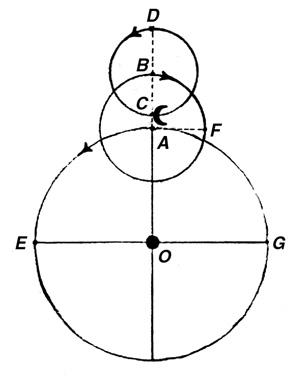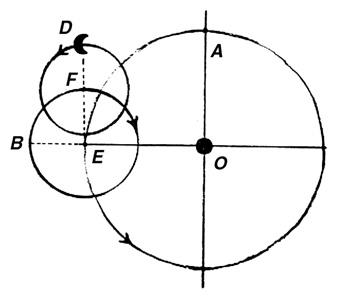
Let O be the center of the Earth and the center of the lunar deferent GAE. Let A be the 7, center of the first (larger) epicycle BF . . ., and B the center of the second (smaller) epicycle CD . . . which carries the Moon. Copernicus postulated that A, the center of the first epicycle, moved from A to E with the velocity of the Moon’s mean sidereal motion. If we then subtract from that the mean sidereal motion of the apparent Sun, the difference is the rate at which A actually travels toward that is, its mean synodic motion. Thus the first epicycle returns to point A in one mean synodic month.
The center B of the second epicycle (which is at the apogee of the first epicycle) is carried toward F at a rate equal to the Moon’s mean motion in anomaly, while the Moon itself travels on the circumference of the second epicycle–beginning at perigee C and traveling toward D–at a rate which is double the rate at which A is traveling toward E. Thus he supposed that he had accounted for both the first and second lunar inequalities.

In the second diagram we see the position of the Moon after the first epicycle has traveled 90°. In this diagram, the equation (angle DOE) is maximized and equals 7;40°. In some particulars this theory represented a clear improvement over Ptolemy’s, although, as Kepler pointed out, it erroneously made the distance of the Moon OD in quadrature greater than the mean radius of the observed orbit, whereas observations required it to be significantly less.